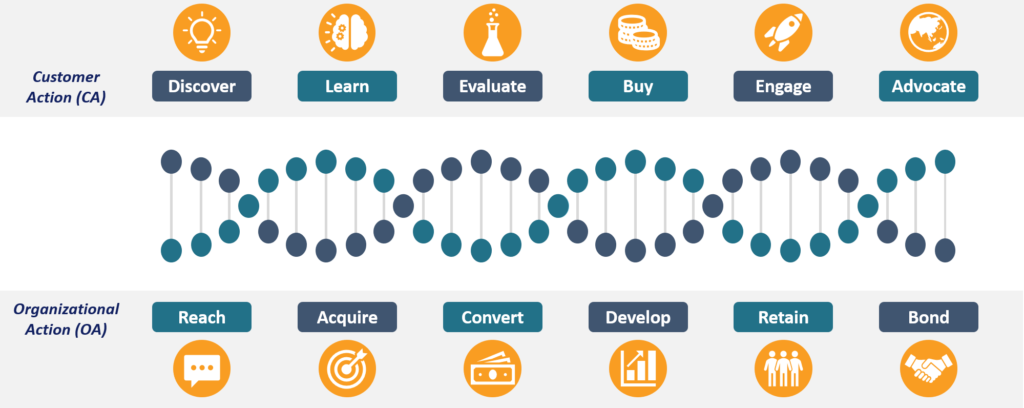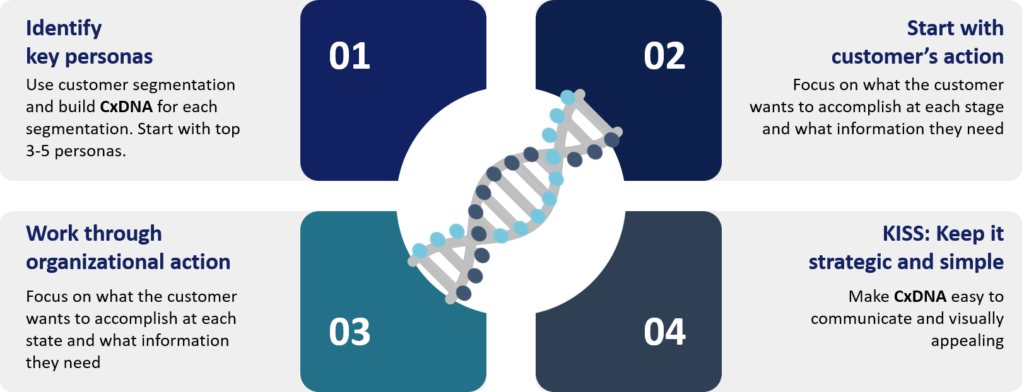by Dr. Rob Nelson –
By now, most organizations have received the “memo”: customer experience is more important now than ever to customers. And, digital transformation underpins this critical priority.
In today's highly competitive and rapidly evolving business landscape, the paramount importance of customer experience cannot be overstated. It has emerged as a critical differentiator, a linchpin of business success, and a driving force behind customer loyalty and advocacy.
Customers today are more informed, connected, and empowered than ever. With easy access to information and a plethora of choices, they have elevated their expectations. They not only seek high-quality products or services but also expect exceptional experiences to go along with them. Meeting or exceeding these expectations is vital to retaining and attracting customers.Today's customers demand and anticipate seamless, hassle-free, swift, enjoyable, and meaningful experiences delivered promptly in a personalized manner. They expect you to “know them”. However, numerous companies are still grappling with the challenge of integrating the essential capabilities, data, and insights required to genuinely meet evolving consumer needs.
Many firms have yet to define the "jobs the customer wants to be done" or taken the time to understand the “customer journey” and the corresponding tasks that organizations must execute proficiently to craft a winning experience throughout the customer journey's lifecycle. Understanding the nature of their customers' experiences remains elusive for many, let alone proactively designing a comprehensive one. A critical hurdle is leveraging essential business model components related to needs and tasks to be accomplished, using customer data and insights to craft and implement real-time initiatives and intelligent decisions that drive customer acquisition, loyalty, and coveted advocacy. The timeless concept of acquiring and retaining customers profitably still holds true, albeit in a far more intricate manner. In the realm of this intelligent universe where minds and machines coexist, the future of Customer Experience is predictive, real-time, and personalized.
Yet, today's businesses have access to a wealth of customer data that can be leveraged to personalize experiences. Analyzing this data enables companies to understand customer preferences, behavior patterns, and pain points. By using these insights, businesses can tailor their offerings and interactions to meet individual customer needs.
Let’s consider some customer experience trends as we emerge from the world of everything gone crazy in the socially distant, contactless world of pandemics.
- Customer experience is more important than ever to customers.(mic drop). No, really!
- It’s a black box. If AI is a black box so has been customer experience. We still struggle at defining what Customer Experience means. But let’s agree on one thing it is not: customer service. Truly understanding, designing and delivering winning customer experience requires seeing the bigger picture and building the requisite customer-centric culture, processes, and technology (more on that in just a moment).
- Who is in charge of customer experience anyway? Studies show that only 16% have customer experience teams with dedicated budgets. Only 23% have a customer experience leader that reports to the CEO.
- Your success strategy is wholly intertwined with a Customer Experience strategy. We have pressed the limits of our business models, channels, and full-on omnichannel transformation. 78% of customers preferred to use different channels depending on their context1. Responding to this demand seamlessly in a frictionless and consistent manner is no easy task – and it does not happen by luck. So, honestly, how do you deliver what customers need and want today and well beyond?
- The paradigm has shifted: ya think? Customers expect hyper-personalization, contactless and self-service options, and a genuinely omnichannel, integrated experience. Thank you, Coronavirus, for your helping nudge. From telehealth to meal-delivery: we have all know the accelerated metrics of growth of digital business transformation.
- It is still about relationships but more. Customer Experience is indeed more about relationships versus transactions. Customers are paying attention to you and assessing your brand. How well do you know them, anticipate their needs, empathize with them? If your processes are inhuman – how on earth can your delivery (haphazardly)of an experience be successful when evaluated against a human scale. Empathy will be a top customer experience metric. Emotive technology will become increasingly important in the customer experience design model.
- Experience isn’t enough anymore. The expectation now is to deliver INCREDIBLE and INTIMATE. Maintaining and accelerating momentum is critical now. This is the time to push further to the next evolution. And, Experience will finally – it hasn’t yet for you – become a “whole team game.”
- Driving to personalization and hyper-personalization and the optimal customer experience requires partnership with customers built on Trust. This includes being transparent and up-front about the use of data and your intentions. Relationships are built on Trust.
- Customer Loyalty and retention are more important than ever. The good news is AI/Machine learning can really help us out here.
- The “ZERO Customer Experience” is when zero thinking by the customer by outsourcing individual decisions to intelligent machines. More of that, freaky and or creepy as it may seem sometimes. Remember, paradigms are shifting.
Acquiring new customers can be costly and time-consuming. In contrast, nurturing existing customers through exceptional experiences can lead to long-term loyalty and repeat business. Loyal customers not only spend more but also become brand advocates, spreading positive word-of-mouth and attracting new customers. he significance of customer experience in today's business landscape cannot be overstressed. It is not merely a buzzword or a trend but a fundamental driver of success. Businesses that prioritize and invest in creating exceptional customer experiences stand to reap the rewards of customer loyalty, positive brand reputation, and sustainable growth in an increasingly competitive marketplace. To thrive in this environment, embracing a customer-centric approach is not an option; it's a necessity. RCG’s CxDNA framework and solutions can help accelerate your integrated approach to customer experience; taking advantage of the latest in technology.
Faced with this reality about the demands of Customer Experience, what should we do? Well, many things that involve your entire business model should be considered. But, let’s start with some baseline priorities:
- Do you know your customers? Have you correctly set up your top 3-5 personas? Have you decided on your key segments, and do you know them? Do you have empathy maps?
- Do you know the jobs they are trying to get done throughout their entire journey with you? What are their experience expectations? What are the gaps? How are you doing? Are you losing prospects or customers along the way? Why?
- Do you truly understand what your organization must to meet and deliver on the “jobs to be done” and the desired experience?
Even if you said yes to all or most of the above. Let me ask again: Really?
Consider the Customer xDNA, a framework that will help you organize your thinking about how to think about customer experience management. Have you indeed mapped and visualized your customer jobs to be done? By segment?
Why DNA? Because the DNA is a double helix, it’s an; it’s two strands interwoven. We have another analogy of two strands of actions. There’s the customer action strand and the organizational action strand.

It should be no surprise that your effort must start with segmentation and persona development. Customer first, right? Yet, in all my years of working with organizations, including dozens of start-ups as well as large privately and publicly held firms, I have found this to be one of the top two stumbling blocks I’ve seen firms struggle with. The other is a lack of focus.
So, what does the Customer xDNA4 mean from that perspective:
Strand A: Focus on the customer the jobs they want to be done:
The prospect / customer is going through a series of steps or stages in their journey with your firm, on their experience that begins with discovery, and then learning about the problem that they have, looking at the evaluation of parts of possible solutions to their problem or the product/solution that they’re looking for, then there’s the actual purchase decision. And finally, there’s the usage and engagement with the product, and the company, and advocacy; if they’re happy with the experience. Each step of the way there are key jobs to be done.
Strand B: Focus on the organizational action:
Now, you obviously want to reach customers, to make them aware of your products and services and your brands, you want to acquire them, which means that you want to bring them on board, get them to sign up with you, get them to try your products/solutions, then you want to convert them into paying customers.
After you convert prospects into paying customers, you want to develop the customer relationship, get them to buy more frequently from you, buy more products from you, to increase the lifetime value. Next, you want to make sure that you retain your customer, that they don’t churn, that you don’t lose them. And finally, you want them to become loyal to you and advocate for your company or your brand or your products to other people. Each step along the way, you have jobs to be done. And, you much orchestrate all of this for the smooth, frictionless experience.
Now, with CxDNA in hand, you have a design-build problem.
You must design the experience and then build it and iterate and adapt over time. But like any killer value proposition, it must be focused on the jobs to be done. The solution must be integrated and holistic. With that said, don’t forget to pat yourself on the back for getting to the CxDNA. Don’t discount the incredible win and value of actually visualizing this CxDNA and getting your entire organization on the same page about it and what it means and the opportunities it will drive. The process of designing, implementing then usually requires technology, strategy, and data and analytics capabilities. So, driving your solution through a digital transformation roadmap is an obvious next step or input.
This framework is also instrumental in driving AI strategy and opportunities and or supplementing with an AI and Automation Strategy and COE. Other considerations may be the need to build or bolster a Data Refinery, a Trusted Data Foundation, enabling real-time, streaming intelligent analytics, making your digital workforce and automation and center of excellence (COE), and even driving your new sources of innovation in your business model.
4 Best Practices for Creative Effective CxDNA

This is an exciting time for sure. We have been a bit through the fire this past year, but we have unleashed many chains, and opportunity abounds in a new paradigm.
Want to learn more? At RCG Global Services, we would love to help. Would you like to brainstorm with us? We have smart people, methods and tools and we will help you realize your customer experience and digital transformation ambitions.
2021 is a landmark year in the adventure into the new healthcare frontier of “healthcare unchained.”
Works Cited
- Customer Think (2020, Oct 11) "2021 Customer Experience Trends and Tactics" Retrieved from
https://customerthink.com/2021-customer-experience-trends-and-tactics/ - Forbes (2020, Dec 17) "Customer Experience Related Predictions for 2021" Retrieved from https://www.forbes.com/sites/adrianswinscoe/2020/12/17/11-customer-experience-related-predictions-for-2021/
- Steven Van Belleghem (2020, Dec 7) "8 Customer Experience Trends for 2021" Retrieved from https://www.stevenvanbelleghem.com/blog/8-customer-experience-trends-for-2021/
- The Customer xDNA framework has been developed by Dr. Mohanbir Sawhney at Northwestern University, Evanston, IL

